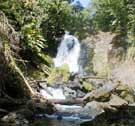
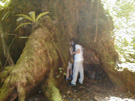
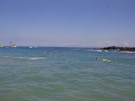
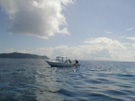
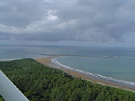
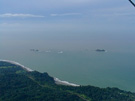
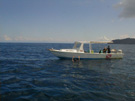
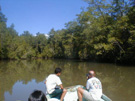
CORCOVADO NATIONAL PARK
The National Park Corcovado, southeast at the Osa Peninsula, is one of the most biodiverse regions of Costa Rica.
The Park is home of the largest population of Scarlet macaws in the country and protects more than 500 species
of trees (representing 25% of all tree species in Costa Rica), among which the biggest tree in the country;
a "ceibo" higher then 200 feet. Furthermore the park is inhabited by 140 species of mammals, 367 species of birds,
117 amphibians and reptiles, 40 species of fish and approximately 6000 different kinds of insects. Some of the
species threatened by extinction which live here are the danta, the giant ant eater and the six species of wild cats,
which are the Puma, the jaguarundi, the ocelot, the margay, the "tigrillo" and the jaguar.
Tour to Corcovado National Park, entrance at ranger station San Pedrillo, guided hike to the waterfall and
another trail.
Hiking Corcovado National Park
Full day tour hiking Corcovado National Park, US$
95.- pp, includes: transportation hotel to Sierpe (point of
embarkation) vv, leaving 6.30 am, professional bilingual nature
guide, boat tour to San Pedrillo � Corcovado{s most northern park
entrance, guided hike to the waterfalls, lunch at the beach. Return
at the hotel around 6 pm.
|
back |
ISLA DEL CA�O
Ca�o island is located 16.5 km west of the Osa peninsula. Ca�o has been declared a biological reserve,
because of its unique flora and fauna and to protect its marine life. The island is covered with tropical rain forest
consisting of approximately 158 different species of plants, among which giant trees growing over 150 feet high.
The fauna at Ca�o is less abundant. Birds represent 10 species. Spotted mammals are: gray four-eyed opossum,
paca, some species of small rodents and various bats. There are small snakes, frogs and lizards.
The island is considered important in respect of its archeological value, as in pre-Columbian times Indians
used it as a burial place. Remnants of ceramic , grinded artefacts and a few of the famous mysterious spherical
shaped stones still remind of those times.
The national reserve Ca�o island protects an important marine environment (2700 marine ha.).
The clear waters are home to of species of fish, invertebrated animals, algae and mammals like dolphins and whales.
The island is surrounded by 5 marine platforms of low coral reef where 15 species of stony corals have been identified.
While underwater one can encounter species of fish like the king angel, Moorish idol, puffers, surgeon fish, snapper,
barracuda, barber fish, parrot fish, dansel fish, and a variety of eels, hiding around the coral lined rock formations.
Turtles, rays and the non aggressive Reef Shark can also be spotted.
It is one of Costa Rica�s premier snorkeling and diving spots.
SNORKELING Cano Island
Full day tour Snorkeling Ca�o Island, US$ 95.- pp,
Includes: transportation hotel to Sierpe (point of embarkation) vv, leaving 6.30 am, professional bilingual nature guide, boat tour to Ca�o Island, snorkeling equipment, guided hike at the island, lunch at the beach. Return at the hotel around 6 pm.
DIVING Cano Island
Full day tour Diving Ca�o Island, US$$ 145 pp
Includes, Transportation hotel to playa Pinuelas
(5 km. north of the hotel), boat tour to Ca�o Island vv, dive equipmen
(two tank dive), professional dive instructor, park entrance, snack.
|
back |
BALLENA MARINE PARK
The national park Ballena is the first marine park in Latin America. It was created in 1990 to protect the coral
and rock reefs. The park covers 13 kilometers of coastline from Punta Uvita to Pinuela Beach and consists of
5,375 hectares of marine environment. From the river Terraba (South of the park),which connects the biggest
mangrove area of Central America to the sea, tons of micro organisms flow into the sea. Another attraction for
bigger and smaller fish and their predators.
The park is a system of reefs and islands called Las Tres Hermanas that protects the coastline which is
made of several unique geological functions and creates some of the best diving and snorkeling in Costa Rica.
The best time for these activities is during the dry season and beginning of rainy season (January till August).
There are 5 species of coral in the park (from the 18 existing ones in the west pacific ocean).
The park waters host swarms of Anchovies, lobsters, catfish, Flying Fish, Trunk Fish, Trigger Fish, Caribbean Snook,
Jew Fish, Common Dolphins and Bottle Nose Dolphins. From December to April the park is home to Humpback
Whales, an endangered species of which only 5,000 remain today.
The sandy beaches of Ballena are visited by the Oliver Ridley and Hawksbill Turtles from May till November,
but mainly in September and October.
Half day tour snorkeling Marina Ballena $ 45 pp.
Includes: boat tour, snorkeling equipment, profesional (dive) instructor, snack, Tour leaves from playa Uvita (15 km. Norte del hotel)
Half day Tour Diving Marina Ballena $ 80 pp.
Includes: boat tour, dive equipment (two
tanks), profesional dive instructor, snack, Tour leaves from playa
Uvita (15 km. Norte del hotel)
|
back |
MANGROVES RIO SIERPE - TERRABA
The mangroves of the rivers Sierpe and Terraba are part of the international reserve "Reserva Forestal del
Humedad Internacional Terraba - Sierpe". It covers 22.000 ha. of mangrove forests.
The reserve is inhabited by a lot of birds. Common species are: reddish egret, white ibis, boat-billed heron
and various kingfishers. Frequently spotted mammals are the white face monky and the crab eating racoon.
Reptiles to be observed most are crocodiles and various kinds of snakes.
BOAT TOUR in the mangroves, with a profesional nature
guide.
$ 25 pp for a 2.5 hours tour.
(Starting time of the tour depends of the tide,
high tide only).
FISHING TRIP in the mangroves & river, accompanied
by a local fisherman, you will experience the fishing with short
cane, trolling, and with small cane.
US$ 25.- pp for a 2-3 hours fishing trip.
del estado de las mareas (s�lo marea baja y en
aumento).
Precio: $ 25 pp.
KAYAK TOUR in the mangroves
Quietly traveling in the shade of the mangrove trees through narrow canals to favored feeding places of varied wildlife. Get up close to see small birds and monkeys. While observing the reptiles from a distance.
US$ 35.- pp for a 3-4 hours kayak trip.
ARTESENAL FISHING
Accompanied by two local fishermen of "Coopemangle", you'll experience fishing in the mangroves of the river
Terraba in 3 different ways:
1. Short cane throwing with artificial bait from the riverbanks.
2. Trolling with artificial bait from the boat in low speed.
3. Fishing with a small cane sitting in the anchored boat.
You can catch fish like red snapper, snook and walaje. Coming back the fishermen prepare the fish caught during
the trip and you'll be able to enjoy fried fish a la "tico" with a salad and a fruit juice.
The tour lasts approximately 4 hours.
(the starting time depends of the tide - low and coming up)
US$ 45.- pp